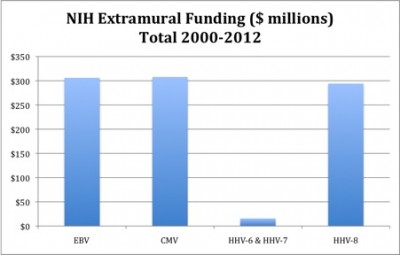 An analysis of several NIH extramural grant information databases (CRISP, Explorer, REPORTer, etc) has indicated a staggering lack of funding appropriated for HHV-6 & HHV-7 compared to other herpesviruses. Since 2000, NIH has given nearly $1 Billion in total grant funding to study the herpesviruses EBV (HHV-4), CMV (HHV-5), and KSHV (HHV-8), compared to only $15 million to study HHV-6 & HHV-7 over the same timeframe (see graph at right).
An analysis of several NIH extramural grant information databases (CRISP, Explorer, REPORTer, etc) has indicated a staggering lack of funding appropriated for HHV-6 & HHV-7 compared to other herpesviruses. Since 2000, NIH has given nearly $1 Billion in total grant funding to study the herpesviruses EBV (HHV-4), CMV (HHV-5), and KSHV (HHV-8), compared to only $15 million to study HHV-6 & HHV-7 over the same timeframe (see graph at right).
An even greater disparity is found when looking at the quantity of grants funded for each virus over this span, as the fifteen grants approved for work on the Roseoloviruses (HHV-6 & 7) are grossly outnumbered compared to the number allocated for EBV (307), CMV (389), and KSHV (254) (table below).
|
Funding for Herpesvirus Research: 2000-2012 |
||||
|
EBV (HHV-4) |
CMV (HHV-5) |
HHV-6 & HHV-7 |
KSHV (HHV-8) |
|
| NIH Extramural Funding ($ millions) |
$306 |
$308 |
$16 |
$294 |
| # NIH grants, 2000-2012 |
307 |
389 |
15 |
254 |
This significant investment of funding allocated toward research on EBV, CMV, and KSHV has produced a wealth of knowledge regarding the pathogenic mechanisms, epidemiology, and gene product functions for each of these herpesviruses, leading to the development of steadily improved diagnostic tools and new virus-specific therapeutic approaches in a rather short timeframe. Unfortunately, no comparable investment has been made in Roseolovirus research, even though the societal burden imposed by the growing list of diseases associated with HHV-6 is now likely to be of the same order of magnitude as for KSHV. As a result, researchers have needed to rely on private funding and limited resources to continue their important work on HHV-6 & HHV-7 over the past several years, and vital information regarding the biological and pathogenic nature of these viruses has not progressed to the point many hoped it would by this time.
An immediate, substantial, and targeted investment by NIH in Roseolovirus research is needed to establish a healthy cohort of researchers and research programs in this area. In the absence of this investment, the underdeveloped state of Roseolovirus research will prevent Roseolovirus-related research proposals from being competitive for funding in the face of the well-developed research infrastructure already available for many other viruses of similar societal importance.
For additional information on grants given for each virus in the review, please contact Dharam Ablashi via email at Dharam_Ablashi@HHV-6Foundation.org
